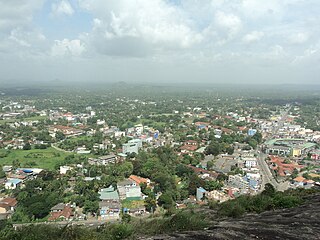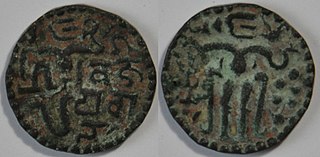Related Research Articles
Kalinga Magha or Gangaraja Kalinga Vijayabahu was an invader from the Kingdom of Kalinga who usurped the throne from Parakrama Pandyan II of Polonnaruwa in 1215. A massive migration followed of Sinhalese people to the south and west of Sri Lanka, and into the mountainous interior, as they attempted to escape his power. Magha was the last ruler to have his seat in the traditional northern seat of native power on the island, known as Rajarata; so comprehensive was his destruction of Sinhalese power in the north that all of the successor kingdoms to Rajarata existed primarily in the south of the island.
Dambadeniya (DMBD) is a ruined ancient city situated in the North Western Province (Wayamba), Sri Lanka on the Kurunegala–Negombo main road. It served as the capital of Sri Lanka in the mid 13th century. Much of Dambadeniya still lies buried on a huge fortified rock. Dambadeniya is situated about 31 km from Kurunegala, the modern day capital of the North Western Province. Dambadeniya is situated about 4 km from Giriulla.

The current legislative capital of Sri Lanka is Sri Jayawardenepura Kotte and the executive and judicial capital is Colombo. Over the course of the island's history, the national capital has been in several locations other than Sri Jayawardenepura Kotte, the following is a list of cities which have historically served as the capital city of Sri Lanka and its predecessor states.

The Kingdom of Dambadeniya was a medieval kingdom in what is present-day Sri Lanka. The kingdom's rulers reigned from 1220–1345.

Narammala(නාරම්මල) is a town in Kurunegala district, northwestern province, Sri Lanka. It is connected to Sri Lankan transport network by Kurunegala-Colombo 5 road and Kurunegala-Negombo 34 road. Narammala is 74 km away from Colombo and 18 km away from Kurunegala. This beautiful town is surrounded by blocks of Paddy fields and Coconut estates. Narammala is where the world's first and only betel research lab and institute is situated. It is situated at Dampelessa which is 3.5km far from Narammala town towards Giriulla.
Bhuvanaikabahu VII was King of Kotte in the sixteenth century, who ruled from 1521 to 1551. He was the eldest son of Vijayabahu VII of Kotte, whom he succeeded, and his chief queen Anula Kahatuda. He was born in 1468 and his brothers were Mayadunne of Sitawaka and Rayigam Bandara. After his father married a second time, his new queen brought a son from another relationship called Deva Rajasinghe, who the king intended to pass on the crown to, and Bhuvanaikabahu and his two brothers responded by fleeing the kingdom, and on their return they had an army given by the King of Kandy.
Vira Parakramabahu VIII, also known as Ambulagala Kumara, was King of Kotte in the fifteenth century, who ruled from 1484 to 1518. He succeeded Parakramabahu VII and was succeeded by his son Dharma Parakramabahu IX. Another son Vijayabahu VII also became king.
Vira Bahu II was King of Gampola who ruled from 1391/2 to 1397. He succeeded Bhuvanaikabahu V and was succeeded by Vira Alakesvara. He may have been succeeded two of his sons in the year 1397.
Vijayabahu III was the first King of Dambadeniya, who ruled from 1220- 1224. He was also called "Kali-Kala Sarvagna Pandith". He was a member of the Sinhala Royal Family who began the Siri Sanga Bo dynasty, he was succeeded by his son Parakkamabahu II. Before he became the king of Dambadeniya, he was a ruler of a small province – a Vanni chieftain. Vijayabahu III brought the relic of the tooth of the Buddha to Dambadeniya – after it was hidden in Kotmale with the invasion of Kalinga Magha – and was placed in the Beligala Temple of Tooth. At that time, people of Dambadeniya considered the possession of the aforementioned relic, a clear indication that Vijayabahu III was the rightful King of Dambadeniya.
Bhuvanaikabahu IV was the first King of Gampola who ruled from 1344/5 to 1353/4. He succeeded his father Vijayabahu V of Dambadeniya and became the King of Gampola. He was succeeded by his brother Parakkamabahu V.

Parakramabahu II, also known as Panditha Parakramabāhu, was the King of Dambadeniya in 13th century, whose reign lasted from 1234 to 1269. As a pioneer in literature, he was bestowed with the honorary title "Kalikala Sahitya Sarvagna Pandita". Parakramabahu's reign is notable for the creation of numerous Sinhalese literal works such as, Kausilumina, Pūjāvaliya, Pāli Vishuddḥi Mārgaya, Thūpavaṃsa and Sidhath Sangarāva. He launched a campaign against the Eastern Ganga invader Kalinga Magha, and successfully expelled him in 1255, unifying Sri Lanka under one rule. He succeeded his father Vijayabahu III as King of Dambadeniya, and was succeeded by his elder son, Vijayabahu IV, after his death.

Vijayabahu IV was King of Dambadeniya in the 13th century, who ruled from 1267/8 to 1270. He succeeded his father Parakkamabahu II as King of Dambadeniya and was succeeded by his brother Bhuvanaikabahu I after being murdered consequent to a conspiracy.

Bhuvanaikabahu I was King of Dambadeniya in the 13th century, who ruled from 1271 to 1283. He succeeded his brother Vijayabahu IV as King of Dambadeniya and an Interregnum of 19 years is thought to have occurred after his death. His nephew Parakkamabahu III ruled from Polonnaruwa, and was not formally considered as a King of Dambadeniya.
Parakramabahu III was a medieval king of Dambadeniya, from 1302 to 1310. He succeeded his uncle Bhuvanaikabahu I as King of Dambadeniya and was succeeded by Bhuvanaikabahu II.
Bhuvanaikabahu II was King of Dambadeniya in the 14th century, who ruled 1310 from to 1325/6. He succeeded his cousin Parakkamabahu III as King of Dambadeniya and was succeeded by his son Parakkamabahu IV.
Parakkamabahu IV was King of Dambadeniya in the 14th century, who was also a scholar known as Pandit Parakramabahu. He built a temple for the Tooth Relic at Kurunegala and was responsible for writing Dhaladha Siritha, a book that laid down procedures for uninterrupted conduct of paying homage to the sacred relic. He renamed Mahanuwara (Kandy/මහනුවර) as Senkadagala. He extended patronage to Vijayaba Pirivena, Asgiriya Temple, and Sri Ghanananda Pirivena. He succeeded his father Bhuvanaikabahu II as King of Dambadeniya and was succeeded by Bhuvanaikabahu III.
Bhuvanaikabahu III was King of Dambadeniya in the 14th century, who reigned in the year 1325/6. He succeeded Parakkamabahu IV as King of Dambadeniya and was succeeded by Vijayabahu V.

House of Siri Sanga Bo was a powerful dynasty which ruled parts of Sri Lanka from Vijayabahu III of Dambadeniya (1220–1224) until Rajasinha I of Sitawaka (1581–1591). Vijayabahu III of Dambadeniya routed Kalinga Magha's armies from Maya Rata and established his fortress at Dambadeniya. This dynasty was able to protect their independence by facing so many foreign invasions thereafter. They had to change their capital city to Dambadeniya, Yapahuwa and Kurunagala because of continuous invasions from southern India.

The Transitional period of Sri Lanka spans from the end of the Kingdom of Polonnaruwa, in 1232, to the start of the Kandyan period in 1597. The period is characterised by the succession of capitals that followed the fall of the Polonnaruwa Kingdom and the creation of the Jaffna kingdom and Crisis of the Sixteenth Century.
